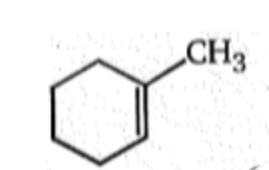The reaction,

 is the example of:
is the example of:
(a) sulphonation (b) dehydration
(c) alkylation (d) decomposition
अभिक्रिया

 , किसका उदाहरण है?
, किसका उदाहरण है?
(a) सल्फोनीकरण (b) निर्जलीकरण
(c) ऐल्किलन (d) अपघटन

 is the example of:
is the example of:
 , किसका उदाहरण है?
, किसका उदाहरण है? Product; Product is:-
Product; Product is:-
(a) 



उत्पाद क्या है?
(a) 


The shortest bond distance is found in
(a) diamond (b) ethane
(c) benzene (d) acetylene
किसमें सबसे छोटी बंध दूरी पायी जाती है?
(a) हीरा (b) एथेन
(c) बेंजीन (d) एसिटिलीन
Which of the following is a correct statement regarding the relative acidic character of cyclopropane and propane?
1. Cyclopropane is more acidic than propane
2. Propane is more acidic than cyclopropane
3. Both are equally acidic
4. Bothe are neutral
साइक्लोप्रोपेन और प्रोपेन के सापेक्ष अम्लीय लक्षण के बारे में निम्नलिखित में से कौन सा सही कथन है?
1. साइक्लोप्रोपेन प्रोपेन की तुलना में अधिक अम्लीय है
2. प्रोपेन साइक्लोप्रोपेन की तुलना में अधिक अम्लीय है
3. दोनों समान रूप से अम्लीय हैं
4. दोनों उदासीन हैं
Ozonolysis of 2,3-dimethylbut-1-ene followed by reduction with zinc and water gives
1. methanoic acid and 3-methyl-2-butanone
2. methanal and 3-methyl-2-butanone
3. methanal and 2-methyl-3-butanone
4. methanoic acid and 2-methyl-3-butanone
2,3-डाइमेथिलब्यूट-1-ईन का ओजोनोपघटन के बाद ज़िंक और जल के साथ अपचयन पर क्या देता है?
1. मेथेनोइक अम्ल और 3-मेथिल-2-ब्यूटेनोन
2. मेथेनेल और 3-मेथिल-2-ब्यूटेनोन
3. मेथेनेल और 2-मेथिल-3-ब्यूटेनोन
4. मेथेनोइक अम्ल और 2-मेथिल-3-ब्यूटेनोन
Di-imide (N2H2) is used to reduce double bond of:
(a) (b) (c) -NO2 (d) -CH=CH-
डाइ-इमाइड (N2H2) का उपयोग किसके द्वि बंध को अपचयित करने के लिए किया जाता है?
(a) (b) (c) -NO2 (d) -CH = CH-
Observe the following sequence of reactions.
The product R is :
| (1) |  |
| (2) | |
| (3) |  |
| (4) |  |
अभिक्रियाओं के निम्नलिखित अनुक्रम का निरीक्षण कीजिए।
उत्पाद R क्या है?
| (1) |  |
| (2) | |
| (3) |  |
| (4) |  |
(Only one enantiomer is taken)
Which of the following statement is correct about A and B ?
(a) A and B are mixture of diastereomers
(b) A and B are mixture of enantiomers
(c) A and B are optically active
(d) B is racemic mixture
(केवल एक प्रतिबिंब रूपी समावयव लिया गया है)
निम्नलिखित में से कौन सा कथन A और B के बारे में सही है?
(a) A और B अप्रतिबिंबी त्रिविम समावयव का मिश्रण हैं
(b) A और B प्रतिबिंब रूपी समावयव का मिश्रण हैं
(c) A और B प्रकाशिक सक्रिय हैं
(d) B रेसिमिक मिश्रण है
Liquid hydrocarbons can be converted to a mixture of gaseous hydrocarbons by:-
1. oxidation
2. cracking
3. distillation under reduced pressure
4. hydrolysis
तरल हाइड्रोकार्बन को गैसीय हाइड्रोकार्बन के मिश्रण में किसके द्वारा परिवर्तित किया जा सकता है?
(a) ऑक्सीकरण
(b) भंजन
(c) कम दाब में आसवन
(d) जलअपघटन
Consider the following sequence of reactions.
The products (B) and (C) are
(a) benzaldehyde and acetaldehyde
(b) benzoic acid and acetic acid
(c) phenol and propionaldehyde
(d) phenol and acetone
अभिक्रियाओं के निम्नलिखित अनुक्रम पर विचार कीजिए।
उत्पाद (B) और (C) हैं-
(a) बेन्जैल्डिहाइड और ऐसीटैल्डिहाइड
(b) बेंजोइक अम्ल और एसीटिक अम्ल
(c) फीनॉल और प्रोपियोनल्डिहाइड
(d) फीनॉल और एसीटोन









